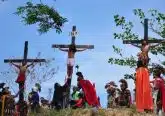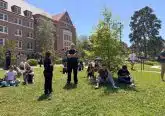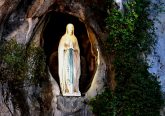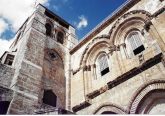Pope names apostolic visitor to Medjugorje

IMAGE: CNS photo/Paul Haring
By Junno Arocho Esteves
VATICAN CITY (CNS) — Pope Francis has named as apostolic visitor to Medjugorje the Polish archbishop he had initially sent to the town as his personal envoy to study the pastoral needs of the townspeople and of the thousands of pilgrims who flock to the site of the alleged Marian apparitions.
The pope appointed Archbishop Henryk Hoser, the retired archbishop of Warsaw-Praga, Poland, to be apostolic visitor to Medjugorje, Bosnia-Herzegovina, for an indefinite period, the Vatican announced May 31.
“The mission of the apostolic visitor has the aim of assuring a stable and continuous accompaniment of the parish community of Medjugorje and of the faithful who go there in pilgrimage, whose needs require special attention,” the Vatican announcement said.
Greg Burke, director of the Vatican press office, told journalists that Archbishop Hoser “will reside in Medjugorje” and that his mission does not involve investigating the authenticity of the alleged apparitions.
Archbishop Hoser’s mission “is strictly pastoral and not doctrinal,” Burke said.
The Polish archbishop was appointed in February 2017 as the pope’s special envoy to study the pastoral situation in Medjugorje.
At a news conference following his first visit, Archbishop Hoser said that although he has no authority or expertise to discuss the authenticity of the alleged apparitions, it was clear that “there is a special spiritual climate” in Medjugorje.
“The biggest miracle of Medjugorje are the confessions” of hundreds of people each day, Archbishop Hoser told reporters in April 2017
In 1981, six young people claimed that Mary had appeared to them. Some of the six say Mary still appears to them and gives them messages each day, while others say they see her only once a year now.
Diocesan commissions studied the alleged apparitions in 1982-1984 and again in 1984-1986, and the then-Yugoslavian bishops’ conference studied them from 1987 to 1990. All three commissions concluded that they could not affirm that a supernatural event was occurring in the town.
In 2010, retired Pope Benedict XVI established a papal commission to study the alleged apparitions; the commission was chaired by Cardinal Camillo Ruini, retired papal vicar of Rome.
The commission’s report has not been made public, although some of its points were revealed after Pope Francis spoke about the commission’s work.
Pope Francis acknowledged that pilgrims to the Marian site deserve spiritual care and support, but he also expressed doubts about claims of the continuing apparitions of Mary in Medjugorje.
During his flight to Rome from Fatima, Portugal, in May 2017, the pope told journalists that, regarding the Medjugorje commission’s work, “three things need to be distinguished.”
“About the first apparitions, when (the ‘seers’) were young, the report more or less says that the investigation needs to continue,” the pope said, according to the English translation posted on the Vatican website.
“Concerning the alleged current apparitions, the report expresses doubts,” he said. Furthermore, “personally, I am more ‘mischievous.’ I prefer Our Lady to be a mother, our mother, and not a telegraph operator who sends out a message every day at a certain time — this is not the mother of Jesus.”
Pope Francis said his “personal opinion” is that “these alleged apparitions have no great value.”
The “real core” of the commission’s report, he said, is “the spiritual fact, the pastoral fact” that thousands of pilgrims go to Medjugorje and are converted. “For this there is no magic wand; this spiritual-pastoral fact cannot be denied.”
After the pope made his remarks, Servite Father Salvatore Perrella, a member of the commission, told Catholic News Service, “The commission did not make a definitive pronouncement.” However, he said, in discussing the apparitions that supposedly began June 24, 1981, and continue today, the commission opted to distinguish between what occurred in the first 10 days and what has occurred in the following three decades.
“The commission held as credible the first apparitions,” he said. “Afterward, things became a little more complicated.”
The Medjugorje commission recommended that Pope Francis lift the ban on official diocesan and parish pilgrimages to Medjugorje and that he designate the town’s parish Church of St. James as a pontifical shrine with Vatican oversight, the Servite said.
Such decisions would be “an intelligent pastoral choice,” Father Perrella said, and they could be made whether or not the church officially recognizes the apparitions as “worthy of belief.” Allowing pilgrimages and designating the church as a shrine would be a recognition of the prayer, devotion and conversion millions of people have experienced at Medjugorje.
At the same time, he said, it would ensure that “a pastor and not a travel agency” is in charge of what happens there.
– – –
Follow Arocho on Twitter: @arochoju.
– – –
Copyright © 2018 Catholic News Service/U.S. Conference of Catholic Bishops. www.catholicnews.com. All rights reserved. Republishing or redistributing of CNS content, including by framing or similar means without prior permission, is prohibited. You may link to stories on our public site. This copy is for your personal, non-commercial use only. To request permission for republishing or redistributing of CNS content, please contact permissions at [email protected].













